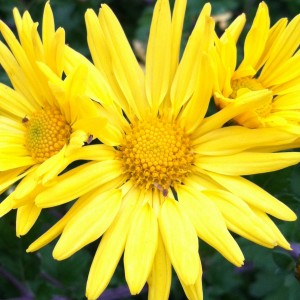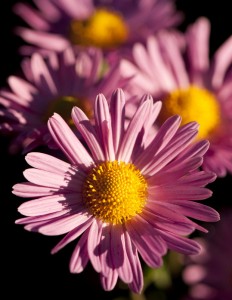Mum Madness: Vote for Your Favorite New NYBG Mum!
Posted in Gardening Tips, Gardens and Collections on October 26 2012, by Sonia Uyterhoeven
Sonia Uyterhoeven is the NYBG’s Gardener for Public Education.
 Korean mums were first hybridized (bred) in Connecticut in the 1930s by a nurseryman named Alex Cummings. He was working on hybridizing cold-hardy varieties that would flourish in New England temperatures. A tall plant–a wild species he mistakenly identified as Chrysanthemum coreanum–fell into his hands and the results were the lavish Korean mums you see planted today in both our Jane Watson Irwin Perennial Garden and the Home Gardening Center.
Korean mums were first hybridized (bred) in Connecticut in the 1930s by a nurseryman named Alex Cummings. He was working on hybridizing cold-hardy varieties that would flourish in New England temperatures. A tall plant–a wild species he mistakenly identified as Chrysanthemum coreanum–fell into his hands and the results were the lavish Korean mums you see planted today in both our Jane Watson Irwin Perennial Garden and the Home Gardening Center.
The chrysanthemum that Cummings was working with turned out to be Chrysanthemum sibiricum, a wild mum with white-pink daisies, vigorous growth, and good branching. This species is also native to Korea, so the popular name of “Korean mum” is correct. Korean hybrids tend to be four feet tall with spectacular, daisy-like flowers that come in a wide range of colors, from pale yellow and dusty pink to burnt-orange and fiery red.
At The New York Botanical Garden, we have a selection program for the Korean mums. Each year we grow a wide variety of Korean mums in a kaleidoscope of colors. In the Perennial Garden, we group them as separate colors–a selection of red mums in the hot room, pink in the cool room–paired beautifully with fall shrubs and perennials to create vibrant autumnal displays.
In the Home Gardening Center, we traditionally plant these mums en masse, collecting the seed at the end of the season to sow the following spring. It is through this process that we come up with new varieties. For the uninitiated, let me explain..

There are two main methods of reproducing a plant: sexual and asexual propagation (propagation = reproducing more plants). Sexual propagation is when you combine genetic material from two different individuals producing variation–the offspring may have similar traits to the parents but are not exact replicas. In this process, pollen from one plant fertilizes the ovules (eggs) of another. Pollinators such as bees are generally in charge of this process, although humans can easily step in and conduct controlled pollination as part of a hybridizing program (as Cummings did). Asexual propagation does not use the reproductive parts of a plant, therefore you get an exact clone or copy of the plant.
Korean mums are propagated sexually by seed and asexually by division or cuttings. If we have a Korean mum that we like–let’s say a pale yellow–we can reproduce it by taking a cutting to produce an exact replica. We take our cutting in spring (May and June), removing about four to six inches from the tops of the stems. We make the cut just below a leaf node and remove the bottom leaves before dipping the cutting in rooting hormone and potting them up in a moist growing medium. It usually takes about three weeks for the cutting to root.
 If, however, we grow this mum in the garden and collect seed at the end of the season, the results we get the next year will be varied. If a bee came along and cross-pollinated the pale yellow mum with an amber colored mum, we might end up with a variety that has pale coppery flowers.
If, however, we grow this mum in the garden and collect seed at the end of the season, the results we get the next year will be varied. If a bee came along and cross-pollinated the pale yellow mum with an amber colored mum, we might end up with a variety that has pale coppery flowers.
We have encouraged the bees to have free reign in the Home Gardening Center, so that while we take either basal or stem cuttings from our tried and true stock bed varieties, we always collect some seed at the end of the year to see if we come up with something new and worth saving. Once the mums flower, we assess the new varieties for a few traits: compact growers (these mums can get really tall), flowering time (some arrive earlier, others later), flower forms (some are single while others have semi-double flowers), and color.
This year we would like to ask you to join us in our selection process. There will be signs in the Home Gardening Center asking you to text in your favorite color choice (you can choose more than one). We have selected six varieties, all of which are included in the gallery below:
[Not a valid template]These colors will be marked in the Korean mum bed among the Trial Beds of the Home Gardening Center, and everyone is welcome to come up and have a look. Voting is set to open on Friday, October 26, after which you can text your choices to 56512 until Thursday, November 8. Be sure to use the proper format–such as NYBG Mango or NYBG Gold–to ensure your vote is counted. Once all the votes are tallied, the results will be posted on Plant Talk as of Tuesday, November 13. We look forward to hearing what you think!


I don’t text, but I went out to see them and ‘NYBG Salsa’ is my hands down favorite.